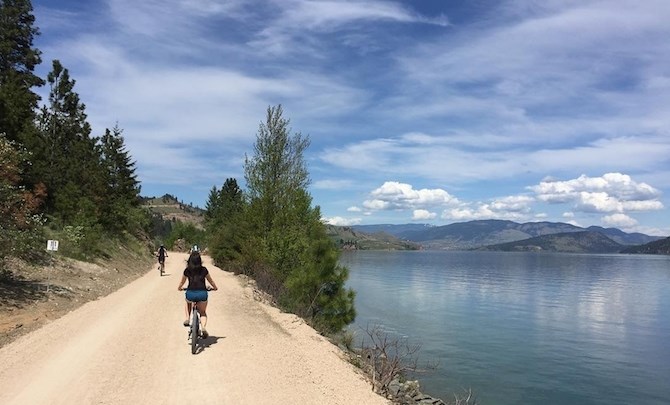Rail and roadways next to the Okanagan Rail Trail shouldn’t come as a surprise
The City of Kelowna has two projects in the works that define what they originally meant by the Okanagan Rail Trail being a “multi-modal corridor.”
In the early heady days of buying and transforming the old CN Rail line into a recreational pathway, it seems many people – including then-Premier Christy Clark – didn’t realize it could one day include roads or rails.
“The intention always was, if there’s an opportunity for multi-modal transportation, that this corridor would be reviewed for that,” Matt Vader, the chair of the local government committee responsible for the corridor, told iNFOnews.ca.
“There’s the corridor and then there’s the rail trail and those are two complementary functions,” he said. “The rail trail is within the corridor and they can both exist at the same time.”
The City of Kelowna is spending $1.2 million – half of it from the province – to plan the extension of Clement Avenue to Highway 33, with much of it being next to the Rail Trail.
READ MORE: City plans to build road next to Okanagan Rail Trail in Kelowna
It is also partnering with UBCO to review options for autonomous (driverless) electric vehicles from downtown to UBCO and Kelowna Airport, along that same corridor.
READ MORE: Driverless bus could become part of the Rail Trail in Kelowna
Both projects will be designed to keep a recreational corridor for cycling and walking in place but it may also mean a busy street with traffic at 60 km/h next to cyclists and joggers.
Local governments got together in 2015 to buy the rail line for $22 million, with politicians like Kelowna Mayor Walter Gray and Regional District of the North Okanagan Board Chair Rick Fairbairn referring to it as a “multi-modal transportation link.”
On the other hand, the provincial government put out a press release on April 7, 2015 pledging $7.2 million (one-third of the purchase price) for an "Okanagan recreational trail."
“By putting an unused rail line to better use, connecting communities as a cycling and walking trail, there will be even more reasons to get outside,” Clark said in the news release.
Lake Country residents went to referendum in April 2015 and voted 75% in favour of borrowing $2.6 million for their share of the trail. While there was some talk at the time about a light rail transit line down the corridor some day, the focus of most of the discussion was on the creation of a recreational trail.
Shortly after the rail line was purchased, a major community fundraising campaign was launched to raise $7.8 million to build the trail along the 50 km route from downtown Kelowna to Coldstream. It officially opened in the fall of 2018, although land along Duck Lake still has not been transferred from the federal government to the Okanagan Indian Band to complete the link.
“It has always been (multi-modal),” Laurie Posthill, chair of the Friends of Okanagan Rail Trail, told iNFOnews.ca. “When I look back to when we were doing the first campaign to raise money for the trail, it was part of the language that was used.”
The trail is about five metres wide, Vader said. But the corridor itself is a minimum of 20 metres wide.
A normal municipal road right-of-way, with water, sewer and sidewalks, is 20 metres but the road surface for a two-lane road is only seven metres, so there is room for both.
“Not every mile on the rail trail is all the same,” Vader said. “They’re not all equal so, to put rapid transit – as an example – down along Kal Lake would be extremely difficult. More difficult than along the side of Enterprise Way.”
While the corridor is at least 20 metres wide along Kalamalka Lake, some of that includes steep hillsides and rock faces so the “constructability” of a road or rail line would be challenging.
For now, the City of Kelowna studies are focused on the 16 km from downtown to the airport and it will still take a few years before anything is built.
But, Vader said, people need to be aware that it’s more than a local recreational trail. It’s also part of a transportation network spanning the Central Okanagan and beyond.
“Part of the rail trail is recreational but part of it is to get people out of their cars so anything we can do to support people not being on a road in a single-occupancy vehicle, holistically, I think we should support that principle,” Vader said. “The idea is not to remove the rail trail itself and the function that has had for the last five years for recreation and active transportation. Those things can all exist within the corridor.”
To contact a reporter for this story, email Rob Munro or call 250-808-0143 or email the editor. You can also submit photos, videos or news tips to the newsroom and be entered to win a monthly prize draw.
We welcome your comments and opinions on our stories but play nice. We won't censor or delete comments unless they contain off-topic statements or links, unnecessary vulgarity, false facts, spam or obviously fake profiles. If you have any concerns about what you see in comments, email the editor in the link above.




